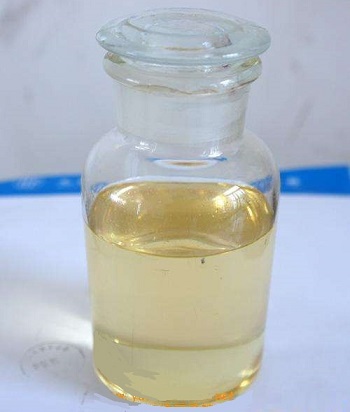Propylidintrimethyltrimethacrylat Chemische Eigenschaften,Einsatz,Produktion Methoden
R-S?tze Betriebsanweisung:
R36/37/38:Reizt die Augen, die Atmungsorgane und die Haut.
S-S?tze Betriebsanweisung:
S26:Bei Berührung mit den Augen sofort gründlich mit Wasser abspülen und Arzt konsultieren.
Chemische Eigenschaften
Trimethylolpropane trimethacrylate (TMPTMA) is a crosslinking agent. It is quite stable in water as it hydrolyses very slowly. However, TMPTMA is inherently biodegradable. It can be assumed that TMPTMA is also biodegradable in soil and sediment and thus can be considered as non persisting in soil and sediment. Trimethylolpropane trimethacrylate rapidly photodegradates in air.

Trimethylolpropane trimethacrylate is used in the preparation of macroporous poly (glycidyl methacrylate-co-trimethylolpropane trimethacrylate) materials with fine controlled porous properties.
Charakteristisch
Trimethylolpropane trimethacrylate is a typical trifunctional monomer, and its viscosity is higher than that of monofunctional and bifunctional monomers, but compared with multifunctional monomers, its viscosity is relatively low, and it has good solubility. This monomer provides high cure speed and high crosslink density, and can form a hard, scratch-resistant and brittle cured film with excellent solvent resistance. Its price is relatively low, although it is irritating to the skin, it is still the most commonly used multifunctional monomer. It is ideal for various coatings anaerobic adhesive and composite applications.
Verwenden
Trimethylolpropane trimethacrylate (TMPTMA) is used as an intermediate product for polymer synthesis in the chemical industry. It is a reactive trifunctional methacrylate suitable for use in a wide ranging number of polymer cross linking functions. TMPTMA is particularly useful as a co-agent in PVC plastisols, plasticizer systems and elastomers. Other applications include as an additive in water based emulsions, adhesives and UV/EB cured coatings.
synthetische
synthesis of Trimethylolpropane trimethacrylate: 40.25g (0.3mol) of trimethylolpropane and 90.41g (1.05mol) of methacrylic acid were added to the reactor equipped with a reflux condenser, a water separator, a thermometer, a stirrer, and an air sampling device respectively to inhibit the polymerization. Agent 0.39g (prepared by hydroquinone: phenothiazine=2: 1 mass ratio), CZ zirconium-based solid acid catalyst 1.21g, with water agent 100ml (prepared by the volume ratio of toluene: cyclohexane=45: 55) ), be gradually warming up to 85 ± 5 ℃ while stirring, the flow velocity that keeps feeding air in the reactor is 7ml/min, at 90-100 ℃ temperature, reacted for 5 hours (when the water agent was brought out without reaction to generate water is the reaction end point), and the filter residue obtained by filtration of the reaction solution is a CZ zirconium-based solid acid catalyst (recovered and reused). Activated carbon 2g was added to the reaction mother liquor, the temperature was raised to 45±5°C with stirring, maintained for 15 minutes, filtered while hot, and the filtrate after the activated carbon was removed was evaporated under reduced pressure to obtain the target product trimethylolpropane trimethacrylate. 110g, the purity is 98.2%, the acid value is ≤0.5mg/g (the acid value detection method is determined according to the method of GB 1668-8), and the esterification rate is 98.2%.
Allgemeine Beschreibung
Trimethylolpropane trimethacrylate is a carbonyl compound.
Propylidintrimethyltrimethacrylat Upstream-Materialien And Downstream Produkte
Upstream-Materialien
Downstream Produkte

